The red-bellied piranha (Pygocentrus nattereri) — is a predatory freshwater fish kind. It belongs to the piranha Serrasalmidae subfamily, which is one of the most well-known kinds of piranha. Due to Hollywood films, it is famous as a bloodthirsty predator, but are piranha really that dangerous? Further in the article, you’ll find information about their habitat, how they hunt, how to keep the fish in a tank, and if it is possible to keep piranha together with other tank dwellers.

Contents
Habitat in the wild
Red-bellied piranha was first described in 1858. The Latin name is given in honor of the Austrian naturalist Johann Natterer (1787–1843). There are many discussions and disagreements about the scientific name, so it’s quite possible that it may change later. However, nowadays, the fish is called Pygocentrus nattereri.
Habitat of red-bellied piranha is the river Amazon and Amazon rainforest, Paraguay-Parana and North-West Brazil coastal river basins, and Essequibo river basin. These rivers’ basins are in Argentina, Bolivia, Brazil, Paraguay, Ecuador, Guyana, Peru, and Uruguay.
Fish has a wide spectrum of geographical variations. Its population on the South is characterized by the golden yellow abdomen, and it’s often called P.nattereri «ternetzi,» but it doesn’t make it a stand-alone kind of piranha. This name appeared when Steindachner described a damaged holotype and named it Serrasalmo ternetzi. You can also rather often encounter the name «superreds.» Nevertheless, the fish coloring may change when being kept in a tank depending on the tank conditions and the food received.
These fishes live in huge schools that spend the majority of their time looking for prey. The fish is rather gluttonous. Therefore it can live only in waters rich in fish. More often, red belly piranha can be encountered in some shallows, in deep and muddy waters. Again, as one of the most known piranha kinds, it has a reputation as a freshwater predator dangerous both to humans and animals.
| Characteristic | Description |
|---|---|
| Scientific Name | Pygocentrus nattereri |
| Common Name | Red-Bellied Piranha |
| Family | Characidae |
| Habitat | Freshwater rivers and streams in South America |
| Size | Up to 12-14 inches (30-35 cm) in length |
| Coloration | Olive green to silver with a distinctive red belly |
| Teeth | Sharp and serrated, used for feeding and defense |
| Diet | Carnivorous – primarily feeds on fish and aquatic animals |
| Behavior | Aggressive and territorial |
| Reproduction | Egg-laying species with parental care |
| Lifespan | Around 10-15 years in captivity |
| Water Parameters | Prefers slightly acidic to neutral water pH, and warm temperatures (75-82°F or 24-28°C) |
| Tank Size | A minimum of 75 gallons for a single adult piranha, larger for groups |
| Tank Setup | Provide hiding spots, strong filtration, and proper water quality |
| Feeding | Offer a varied diet of live or frozen meaty foods |
| Compatibility | Best kept in a species-only tank or with robust, fast-swimming fish |
| Conservation Status | Not evaluated |
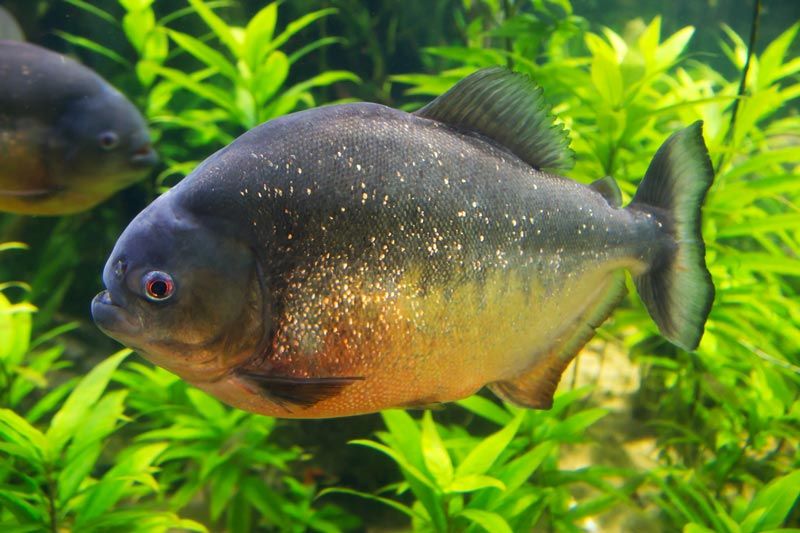
Are piranhas dangerous? Aggression in nature and aquarium
Basing on films and literature, we know that if we only put a hand in the water with piranha in it, they’ll eat it in a minute. Well, maybe things are not that dramatic, but if there is some injury on the hand and the blood gets into the water, piranha can smell it being miles away, and the whole school will attack the human and leave just a skeleton after.
Is it really so?
First, we should understand if red bellied piranha is really an extremely aggressive creature that attacks everything that moves in the water.
Maybe, it sounds strange, but red bellied piranha is a very cautious fish, which poses no threat to humans. There are many cases reported when a man swam harmlessly in the water full of piranhas.
Jeremy Wade was the one to demonstrate this to the full. He put piranhas in a small pool and swam there while several dozens of piranha didn’t even come close to him. However, piranhas, considered to be predators hungry for flesh and blood, are actually quite timid fish.
It is known that they prefer living in large schools, so if you saw one piranha in the water, there are definitely more of them there. However, they stay in schools not because it makes it easier to kill a man in this case, but because they themselves are a part of the food chain for other larger fish species. In a school of ten species, the chances that it is you who’ll be eaten are quite low.
Moreover, experiments have shown that when being alone, the fish feels not that calm as if it was surrounded by others. Still, despite their peaceful attitude towards humans, red bellied piranhas are real killing machines towards other fish kinds who are lower in their food chain. Their strong jaws were made for biting and tearing apart, while their solid well-muscled bodies are capable of moving and twitching incredibly fast under water.
Piranha bite is from 67 to 320 Newton strong, which is quite significant for such a small mouth. This is the strongest bite among all fishes (respectively to their body size), and it is three times stronger than the one of alligators of the same size.
Still, it doesn’t mean at all that these fishes don’t ever bite humans or animals that get into the water. Almost always, such behavior isn’t due to their aggressiveness but because of self-protection or abnormal weather conditions. Due to the change of the latter, their behavior changes drastically from the usual one.
By abnormal weather conditions, we mean dry season when rivers become too dry and in pits with water but cut of from the main stream many fishes are left to starve. These starving predators gradually start eating their kind and are quite likely to attach any creature that gets in the water. Sometimes piranhas’ propensity for aggressive behavior is detected during their spawning period when they attach humans or animals as an act of self-defense. However, such cases are quite seldom.
Description
Size
How big do red belly piranhas get?
Red-bellied piranhas (Pygocentrus nattereri) can grow to a substantial size, especially when provided with proper care and suitable living conditions. On average, these piranhas can reach a length of about 10 to 14 inches (25 to 35 centimeters) in captivity. However, some individuals may grow even larger, occasionally reaching up to 16 inches (40 centimeters) in length.
It’s important to remember that the growth of piranhas can be influenced by factors such as diet, water quality, tank size, and overall care. Providing a spacious tank, a varied and nutritious diet, and maintaining excellent water conditions can promote healthy growth and well-being for red-bellied piranhas in captivity.
Lifespan
How long do piranhas live?
The lifespan of piranhas can vary depending on the species and their living conditions. In general, piranhas have an average lifespan of about 10 to 20 years in the wild. However, in captivity, under proper care and conditions, some piranhas have been known to live even longer, reaching up to 25 years or more.
It’s essential to note that providing appropriate housing, water quality, diet, and overall care can significantly impact the longevity of piranhas in captivity. Regular maintenance of the tank, a well-balanced diet, and suitable living conditions can contribute to a longer and healthier life for these fascinating fish.
Color
Fish coloring depends on its habitat. Its abdomen color varies from yellowish to reddish when the rest of the body is silvery, golden, or black. The head can be of different shape, and it notably depends on the diet. Some species have rather blunt-shaped heads, and some have a small concavity above their eyes, which sometimes can be missing. The fin size depends on the diet peculiarities and its habitat – sometimes, the fin can be very tiny.
Young species have black spots scattered over their silvery body. Their gill covers, pectoral and anal fins, including the abdomen, are bright red. The tail has a wide back edge.
With aging, the black spots disappear, and the body becomes dark silver colored with small golden sparkles on the scales. While red color on the fins and abdomen remains. The fatty fin has no rays, while the dorsal has from 14 to 18 branchy rays. The tail fin that stretches from abdominal fins to anal one is covered with notched sawtooth-shaped scales.
Teeth
It seems quite harmless, but for its large head with a strongly pronounced jaw with sharp, solid triangle teeth, which leave no doubt that this is a dangerous predator. The upper jaw teeth are a bit smaller than these of the bottom one. At that, normally, they are covered with the fish’s massive lips, and only their ends can be seen. Special organization of the teeth and movable bottom jaw let them tear quite large pieces of flesh from the prey.
Predatory lifestyle has affected the fish eyes and nostrils size. Piranhas have a high sense of smell, and they can find their potential prey even in the complete dark among thick vegetation.
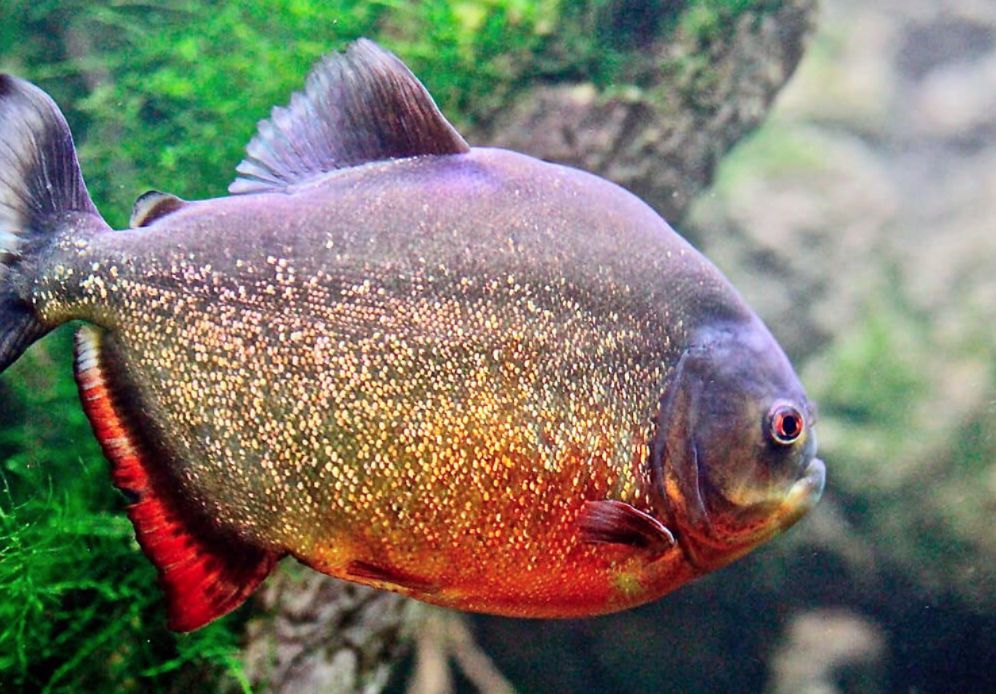
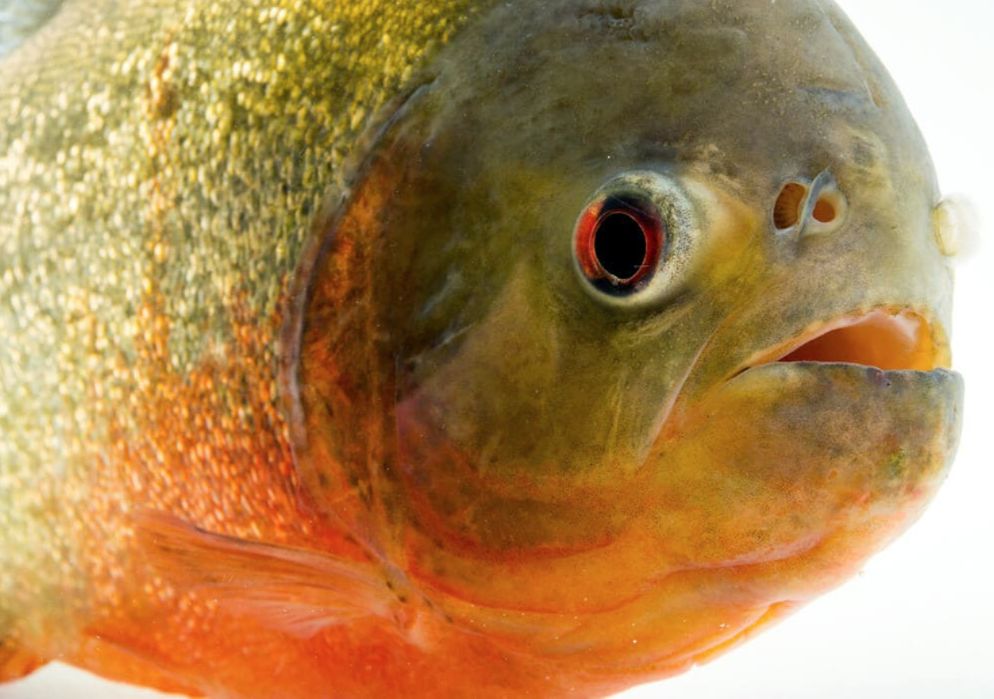
Difficulties in keeping
Due to numerous myths telling about the fish’s lust for blood, piranhas are quite seldom kept in amateur tanks even though they require minimum care.
The fish isn’t demanding as for the food, so it’s quite easy to keep it in a tank.
However, I can’t recommend this fish for not experienced aquarists. The red bellied piranha is large, predatory, and you should be cautious even when maintaining the tank. There were some cases when piranhas attacked and injured their owners. For example, when transporting the fish into another tank, etc.
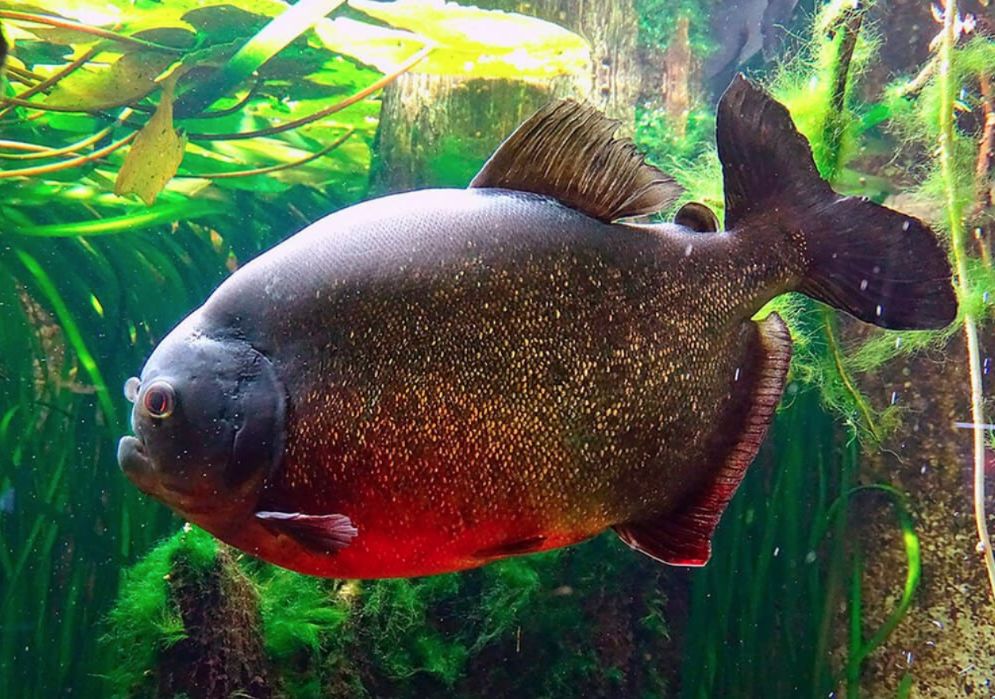
Keeping in a tank
Despite having the reputation of bloodthirsty predators, in captivity, red bellied piranhas are very prone to stress and are very timid. At any sign of danger, the whole school quickly disappears in thick vegetation. The juveniles just lay down on their sides and pretend to be dead.
Thus, there is no sense of being afraid that one day when cleaning the tank, they will bit your finger off. Piranhas will always stay away from unknown objects in a tank. If the fish isn’t hungry, their first reaction to any object put into the tank will be hiding.
However, you shouldn’t forget that you are dealing with a predator, so a cornered adult species when you are trying to catch is quite capable of injuring you. Considering that most aquarists use a scoop-net to catch the fish in a tank, they are the only ones who suffer.
If you don’t feed red bellied piranha for a month and by the end of this time, they won’t eat each other, any object that gets into the tank will provoke them to attack.
How many piranhas should be kept together?
The number of piranhas that can be kept together depends on the size of the tank. Piranhas are known for their aggressive and territorial nature, so it’s crucial to avoid overcrowding the tank, as it can lead to increased stress and aggression among the fish.
For red-bellied piranhas (Pygocentrus nattereri), which are among the most commonly kept species in captivity, it is generally recommended to keep them in groups of at least 3 to 6 individuals. This helps reduce aggression within the group by spreading it out among the fish. A larger group also mimics their natural social behavior in the wild.
However, it’s crucial to have a large enough tank to accommodate a group of piranhas properly. A minimum tank size of 75 gallons is typically recommended for a small group of red-bellied piranhas. As they grow, a larger tank may be required to maintain suitable conditions and reduce territorial disputes.
Remember, even when kept in groups, piranhas should be closely monitored for any signs of aggression or stress. If any individual shows excessive aggression or becomes injured, it may be necessary to separate them from the group to prevent further harm.
Tank size
Adult red bellied piranhas are quite large; even in a tank, they grow up to 8 in (20 cm). In the wild, they live in large schools, so to keep them in a tank, it’s better to get not less than 8-10 species. Fish swims in all water layers.
For a single adult red-bellied piranha, a minimum tank size of 75 gallons (284 liters) is recommended. However, it’s important to note that piranhas are social fish and thrive better when kept in groups. If you plan to keep multiple piranhas, you’ll need to increase the tank size accordingly.
For a group of fish 2 in (5 cm) large, a tank of about 22 gals (150 liters) will be enough for a start, but it’s better to get a more spacious tank because, for a school of adult red bellied piranhas, a tank 110 gals (500 liters) large will not seem to big. The more piranhas you have, the larger the tank should be to accommodate their territorial nature and provide enough swimming space.
Keep in mind that these recommendations are based on providing a comfortable and healthy environment for the fish. Larger tanks also help maintain better water quality, reducing the frequency of water changes and stress on the fish. Additionally, providing plenty of hiding spots and places to establish territories will also contribute to a more harmonious and less aggressive tank environment.
Water parameters
Optimal tank water parameters are the following: temperature 22–30 °C (72–86 °F), pH 5.5-7.5, GH 4-15.
- Temperature: 75-82°F (24-28°C)
- What temperature do piranhas live in? Piranhas are tropical fish and thrive in warm water. Keep the temperature stable within this range to prevent stress and disease.
- pH Level: Slightly acidic to neutral (pH 6.5-7.5)
- Aim to keep the water pH slightly acidic to neutral. Avoid extreme fluctuations in pH as it can stress the fish.
- Ammonia and Nitrite: 0 ppm
- Both ammonia and nitrite are toxic to fish. Maintain undetectable levels of ammonia and nitrite by performing regular water changes and ensuring proper biological filtration.
- Nitrate: < 20 ppm
- Nitrates are less harmful than ammonia and nitrite but should be kept at a low level. Regular water changes help to control nitrate buildup.
- Hardness: Soft to moderately hard water (4-8 dGH)
- Red-Bellied Piranhas can tolerate a range of water hardness but prefer soft to moderately hard water.
- Dissolved Oxygen: Adequate oxygen levels
- Ensure proper water circulation and aeration to maintain adequate dissolved oxygen levels, especially in a well-stocked aquarium.
It is essential to monitor these water parameters regularly using appropriate testing kits and make adjustments as needed. Regular water changes (about 20-25% every two weeks) help to maintain water quality and prevent the accumulation of harmful substances.
Tank decorations and substrate
They don’t play an important role when keeping the fish. You can put sand or small gravels on the bottom, but often they are kept in a tank without bottom substrate. To decorate the tank, you can use various elements: stones, snags, live and artificial plants. The main thing is that they don’t have sharp edges. When the fish gets scared, it often starts swimming like crazy around the tank and can easily get injured.
The best idea is a thickly planted (with live plants) tank with some free areas for the fish to swim, with dim lighting required for the plants.
In these conditions, red bellied piranhas feel more comfortable, become more active, and tend to demonstrate their natural behavior.
Filtration
The most important thing in red-bellied piranha care is that water should always be clean. Every week check ammonia and nitrates content in the tank water using tests and renew the tank water. Water purity is crucial because the fish leaves quite many leftovers when feeding, and the feed contains proteins that start rotting rather fast. It’s also important to have a powerful external filter in a tank.
The way the fish feeds implies a significant load on the tank biosystem. That’s why powerful external filters and weekly 25–30% water renewal are a must. Other necessary equipment that you’ll need is an aerator, heater, and lighting system.
The water flow in a tank should be moderate. You’ll also need a powerful air pump to ensure day-and-night aeration and a thermostat to maintain the water temperature comfortable for this tropical dweller in your tank. You can select the lighting that you like since piranhas can easily stand both dim and bright lighting.
Behavior in a tank
In tanks, red bellied piranhas aren’t quite a crowd puller. They have neither bright coloring (general body tone of the adult species is silvery with black tints with the reddish abdomen and sparklets scattered over the body) nor unusual body shape.
Except for their teeth that are tiny, extremely sharp blades, it’s not likely that the fish would attract the interest of many aquarists. Also, piranhas’ behavior in a tank isn’t something special. Moreover, if the school of fish (you should keep them in schools about 10 or more species) gets scared by something, they start tearing around the tank like crazy.
Panic-stricken, they hit the tank walls, try to hide in any shelter, and even, it happens, that they pretend to ‘faint’ by freezing at some unnatural pose and getting on the tank bottom.
Cannibalism
Do piranhas eat each other? Yes. Cannibalism is peculiar to piranhas, like many other fishes. Besides, not only adult species can do it, but also a bit grown-up juveniles as well. Thus it’s better to get the juveniles from one offspring, this way significantly decreasing the chances of cannibalism in this case.
Cannibalism is usually caused by a tank not spacious enough or a lack of food. If there are too many red bellied piranha juveniles in a tank, they will inevitably bite each other. At that, one part of the injured fish dies, and the other survives due to its high immunity. Besides, their injuries heal quite fats. Just several days later, the bite can be barely seen.
Aggressive behavior is caused by wrong victim behavior from the point of view of its school. This can be a sick or injured fish, and it doesn’t matter if this is one of their kind or another tank dweller.
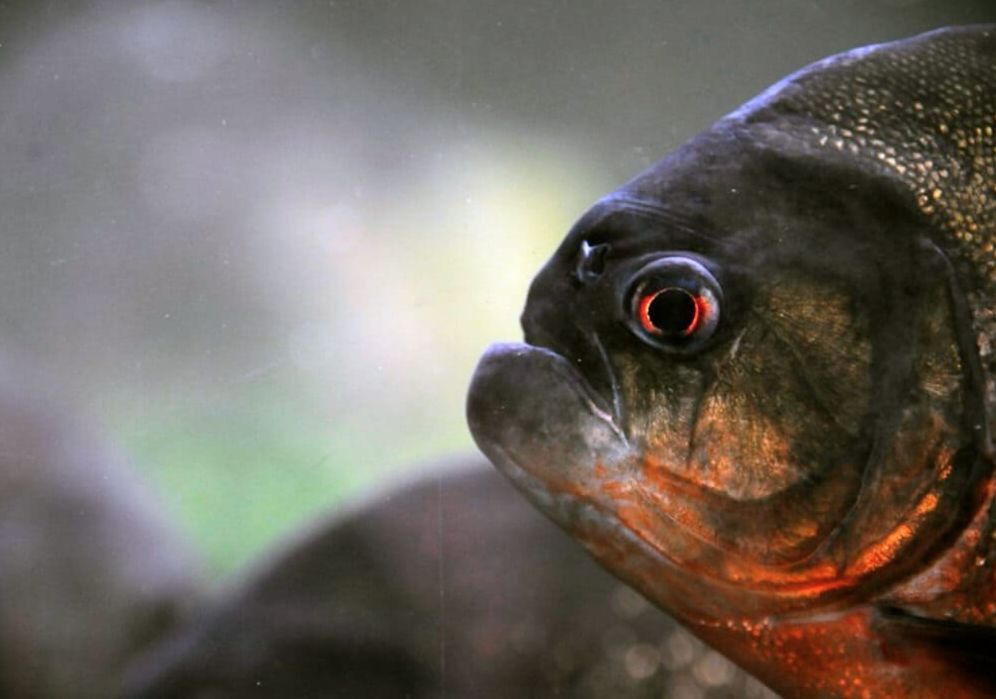
Diet
How often do piranhas eat?
Piranhas are opportunistic feeders and can eat frequently when food is available. In the wild, they may feed multiple times a day, especially during periods of high activity and when food sources are abundant. Their diet mainly consists of fish, insects, crustaceans, and other aquatic animals.
In captivity, the feeding frequency for piranhas can vary depending on their age, size, and the type of diet provided. Younger piranhas may need to be fed more frequently than adults, as they are growing rapidly and require more nutrients. As they mature, the feeding frequency can be reduced.
A common feeding schedule for adult piranhas in captivity is to offer food once a day or every other day. It’s essential to provide a balanced and varied diet to ensure they receive all the necessary nutrients. A mix of live or frozen meaty foods like fish, shrimp, worms, and other protein-rich options is typically recommended.
Keep in mind that overfeeding piranhas can lead to health issues and water quality problems in the tank. It’s best to observe their behavior and adjust the feeding schedule accordingly to maintain their health and well-being. If you are unsure about the appropriate feeding frequency for your specific piranha species, consult with an experienced fishkeeper or a veterinarian with expertise in fish care.
What do red belly piranhas eat?
When chasing its prey, the red-bellied piranha relies on the speed and suddenness of the attack. Sometimes they snook its prey in a hide and attacks from it: all school attacks the prey and eats it, at that each fish acts on its own regardless of any other school members.
The fish is well known for its nose, which helps it to find prey. Piranha easily smells blood near it. In muddy water, they are dangerous to all animals that are within the fish sight. Fishes that become prey start to panic and try to escape one by one, but fast piranhas still catch them – they swallow the small ones right away, and they tear pieces from the large ones and swallow them immediately to continue feeding.
A school of adult red bellied piranhas eats everything that comes on its way. The male fishes even eat water plants. However, scientists have found out that red-bellied piranhas don’t hurt any healthy catfishes of Hoplosternum kind. These catfishes fearlessly come close to piranhas and eat some parasites from their skin.
Piranhas food is first of all fish; also, they attack any mammals while they are swimming or drinking water, and birds which fly close to the water as well. Except for fish, their diet includes insects, crustaceans, mammals, reptiles, and amphibians. Some piranha schools at some specific season dwell under trees where birds build their nests. They are patiently waiting for the moment when a chick falls from the nest.
In a tank, red-bellied piranha feeds on protein-containing feed – fish, fish fillet, frozen prawns, calamari meat, heart, rain-worms, and shed snakeskins, sometimes even live mice. The fish’s everyday diet shouldn’t contain dry market feed, flakes, or granules. A Meat-containing diet should prevail (fish, prawns, worms) with some addition of plant/vegetable components. You have to be careful when feeding piranhas since the fish may bite your hand.
The juveniles should be fed every day, while adults every second day or every day as well. But to prevent obesity, you should arrange for them one or two fasting days a week.
When giving large pieces of food, you should hang them in a wire. When putting it in a tank, at first, the whole school scatter in all directions. Some time later, usually, the smallest species decides to swim closer to the food and bite it. Once all school members make sure that it’s safe, they all attach their prey, and in a blink of an eye, nothing is left.
Quite often, it is mentioned that the fish can almost cut through a steel wire. However, the fact is while feeding, if it feels like eating something solid, the fish will try to bite a smaller piece, and if this doesn’t help, it will refuse to eat this food at all.
When eating its prey, red bellied piranha slices with its razor-sharp teeth all the soft tissues and normally leaves the skeleton untouched. However, when getting excited, it can cut a large fish in halves.
They eat quickly and messy, trying to eat as much as possible for future use. Small pieces of food fallen on the tank bottom are usually ignored. Thus, it is recommended to give them food in pieces that they can swallow at once without tearing them.
For maintaining the red color of the fish coloring, their diet should include shrimps.
Tank mates
The question if red bellied piranha can live with other fishes is one of the most controversial. One says that it’s impossible; the others successfully keep piranhas in a tank with very small fishes. It’s more likely to depend on many factors: how large the tank is, how many plants are in it, the number of piranhas in the tank, their temper, diet, etc.
It’s better to keep a school of 5-10 species. Keeping one fish in a tank may be stressful for it, and loud noises will make it swim away and hide. You can see a clear hierarchy in the school when the strongest species haunts the others and gets the best and tastiest food pieces.
Combining large cichlids with piranhas is generally not recommended due to the aggressive and territorial nature of both fish. Both piranhas and large cichlids are known for their aggressive behavior, and keeping them together can lead to intense territorial disputes, injuries, and even fatalities. Combining these two aggressive and territorial fish in the same tank can result in constant stress for both species and increased risk of injuries or fatalities
What fish can live with piranhas? It’s generally best to keep piranhas in a species-only tank to avoid any risk of aggression or predation towards other fish.
However, if you still wish to add tank mates, there are a few factors to consider:
- Size: Choose tank mates that are similar in size or larger than the piranhas. Larger fish are less likely to be seen as prey and can hold their ground better.
- Aggression and Speed: Opt for fast-swimming and aggressive fish that can defend themselves against piranhas if needed. Species with their own defense mechanisms, like spines or armor, can also be more resilient.
- Observation: Monitor the tank closely after introducing new tankmates to ensure they are not being harassed or harmed by the piranhas.
Here are a few examples of potential tank mates that have been kept successfully with piranhas:
- Silver dollars – sometimes they can get on well in one tank with their close relatives such as pacu, silver dollar. However, conflicts are still possible here.
- Large catfish (e.g., Plecos, Pictus catfish) – It’s easier to keep piranhas with large catfish species: sailfin pleco, striped Raphael catfish, suckermouth catfish. They are perfect red-bellied piranha tank mates since they inhabit bottom water layers and they are protected from attack with bone planes on their body. You may also try some other fishes as piranhas tank mates, but you never know…
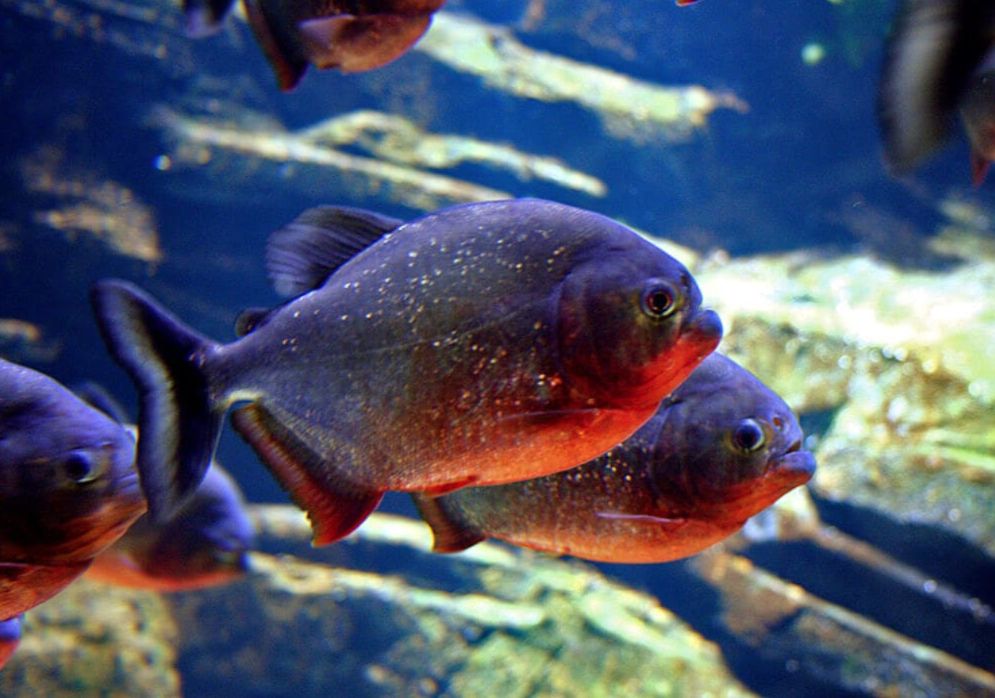
Gender differences: male vs female
It’s rather difficult to see between red bellied piranha males and females. Red-bellied piranhas do not have significant external sexual dimorphism (physical differences between males and females). However, there are a few subtle differences that may help identify males from females:
- Body Size: In some cases, female piranhas may grow slightly larger than males, but this difference is not always easily noticeable.
- Body Shape: Females might have a slightly rounder and fuller body shape, especially during breeding periods when they carry eggs.
- Vent Location: The vent is the opening through which piranhas eliminate waste and reproduce. In females, the vent is usually more rounded and located closer to the anal fin, while in males, it may appear more elongated and closer to the anal fin as well.
- Aggression and Territorial Behavior: Visually you may see the difference only due to continuous observations of the fish behavior, especially during the spawning period. Males become more brightly colored, and the females’ abdomen becomes rounded.
In a home aquarium, sex identification might not be necessary unless you plan to breed the piranhas. Otherwise, focus on providing them with suitable tank conditions, proper diet, and enough swimming space to ensure their overall well-being and h
Breeding
Red bellied piranha start to breed quite easily at 18 months, being 6 in (15 cm) long. Since it’s almost impossible to define the fish gender, the breeders buy about 6-8 species and grow them together. In some cases, the male looks darker colored than the female, which also has a yellowish abdomen.
Piranhas grown in a tank don’t require any special conditions for breeding. The minimal requirement is clean and warm water, sufficient tank capacity, plus a diversified diet.
The spawning doesn’t depend on the season. After the first spawning, the following ones usually occur about once or twice a month.
Piranhas maintain their reproductive ability for quite a long time. Changes in their coloring and some tank environment changes may mean that the spawning is about to start. During this period, their coloring gets darker and becomes almost black.
Tank water acidity and hardness aren’t important when breeding. However, the water temperature should be within 25-27 °C. Red bellied piranhas can breed in a community tank as well as in a separate spawning tank. In the latter case, a tank of 40 gallons capacity should be used (60 gallons is even better). The water is purified using a powerful external filter, and some small pebbles are put on the tank bottom as a substrate. It’s recommended to put some fluctuates in it. They’ll shade the tank and make the fishes feel safer. The beginning of the spawning period is easily seen since the fishes start making a nest, their coloring becomes darker, and they leave their school. The spawning can be stimulated by adding some fish and fresh meat into the piranhas’ diet and raising the water temperature to 28 °C. However, some aquarists decrease the water level first and then pour some fresh water for the same purpose.
The spawning occurs in the open space. During the spawning period, the male fish makes the nest by removing gravel from the tank bottom, and the female fish is swimming nearby at the same time.
After finishing with the nest, the male fish chases the female one till they reach the area which he has cleaned from pebbles. They start swimming in circles, and the female fish lays the eggs, the red bellied piranha male fertilizes them. The clutch of 500-1500 eggs appears there in an hour.
The spawning usually begins in the early morning. The female lays about 1500 bright orange eggs about 2 mm in diameter. This is when its job is done since the male performs all the further care about the eggs.
Red bellied piranha male takes all care about their offspring – he guards the eggs, fans it with his fins. He attacks your hand when he sees it through the tank wall and any other objects that appear within the nest borders.
The male covers the eggs with the bottom substrate. From time to time, he performs abrupt circular movements around the nest and waves the clutch with its fins creating the necessary water flow. For proper hatching, it is recommended to use quite a large-sized substrate as the bottom substrate in the spawning tank. Since a small-sized one gets pressed quickly and the male’s actions only increase the process. As a result, part of the eggs gets suffocated. The hatched larvae don’t have the strength to get from under the substrate.
Then the male’s activities on taking care of the nest reduce day after day. The swimming larvae are now on their own.
Larva appears two days after spawning, and a week later, juveniles start swimming. It’s recommended to remove the juveniles into a separate tank. Start feed for them can consist of brine shrimp nauplii, and later you may feed them with blood worms and other live feed.
Provided with good feeding, the juveniles grow very fast. Being a month old, the juveniles resemble small shiny coins with a dark spot at the beginning of their tail fin.
One more month later, more dark spots appear on their bodies. At the age of three months, their bottom jaw becomes more pronounced, and their fins become colored. Now, they are completely like adult species.
At this age, it is important to add fish and meat to the juvenile’s diet as well as cut shrimps. When switching to this kind of food, you should be extremely attentive to the tank water quality.
If the spawning occurred in a species tank, the larvae and the juveniles could grow in it. They won’t attract any attention of adult red bellied piranhas.
The danger of being eaten is serious when the juveniles become about 2 in (5 cm) large. In a separate spawning tank, such issues may arise when the fish become reproductive.